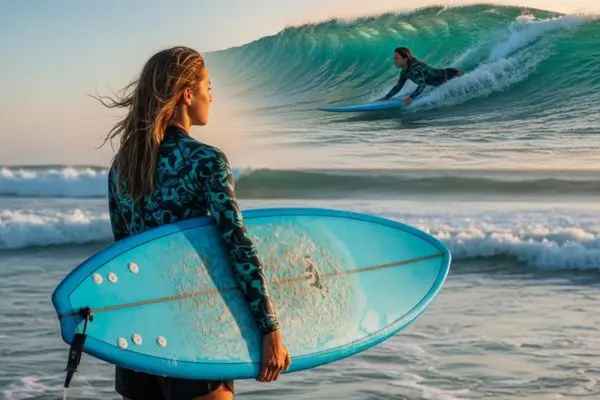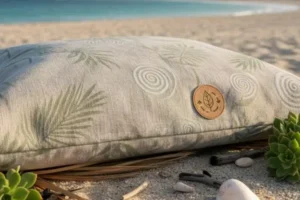The first time you paddle into open water, the ocean feels endless.
It’s vast, unpredictable, and powerful — a world that seems to have its own will. For many beginner women surfers, that immensity brings both fascination and fear. Fear of falling, of being pulled under, of not belonging to something so wild.
But every surfer, no matter how experienced, has felt that same pulse of hesitation. Learning to surf isn’t just about technique — it’s about trust. Trust in your body, in your instincts, and most importantly, in the ocean itself.
Understanding the Fear Beneath the Surface
Fear in the water doesn’t make you weak — it makes you human.
The ocean is alive and constantly changing, and acknowledging that unpredictability is part of what makes surfing so powerful.
For beginners, fear often stems from uncertainty: not knowing what’s beneath the surface, how strong the waves are, or how to handle a wipeout. But fear also comes from internal doubts — the thought that you’re not strong enough, brave enough, or skilled enough to belong in that environment.
What changes everything is learning that fear is not an obstacle to overcome, but a message to understand. It tells you to slow down, to breathe, and to listen. Once you stop fighting fear and start interpreting it, it becomes a guide rather than a barrier.
Learning to Trust the Ocean
Trusting the ocean doesn’t mean believing it will always be kind. It means recognizing its rhythm and respecting its rules. The sea is unpredictable, but it is also consistent in its patterns. Once you learn to read the tides, the sets, and the currents, you begin to see its logic — its language.
Spending more time in the water, even on small or calm days, helps build that trust. Sit on your board. Watch how the surface moves. Listen to the sounds beneath the wind. The more you observe, the less foreign it feels.
With time, you stop seeing the ocean as something to conquer and start seeing it as something to collaborate with. It becomes less about control and more about flow.
Steps to Build Confidence and Safety
Trust grows from preparation and small victories. The more familiar your body becomes with the sensations of being in the water, the calmer your mind becomes.
Here are gentle ways to build ocean trust step by step:
- Start with calm conditions — small, soft waves are perfect for building comfort.
- Learn to float and breathe mindfully — the ability to relax in water builds control and reduces panic.
- Practice falling — learn how to wipe out safely and get used to being under the surface for a few seconds.
- Study the ocean — understand rip currents, tides, and local patterns; knowledge turns fear into awareness.
- Surf with women who support you — a calm and encouraging group makes every experience safer and more joyful.
- Celebrate progress, not perfection — confidence grows in layers, not leaps.
Trust doesn’t appear suddenly; it builds through repeated, respectful encounters.
How Mindfulness Helps You Stay Present
Fear often grows when our minds rush ahead — imagining everything that could go wrong.
Mindfulness brings you back to what’s real: the present moment, the breath, the sensation of water beneath your fingertips.
Before paddling out, take a few deep breaths and observe your surroundings. Feel your heartbeat. Hear the waves. Let your body recognize that you are safe right now.
During a session, try to focus on one thing at a time — your paddle, your balance, your breath. Every time your mind wanders toward worry, return to what’s immediate. The ocean rewards presence; it teaches us that control doesn’t come from force but from awareness.
This same mindfulness applies after surfing. Reflect on what felt good and what challenged you. Each reflection builds understanding — and understanding leads to trust.
The Emotional Side of Ocean Connection
Many women discover that learning to surf isn’t only a sport — it’s an emotional awakening. The ocean becomes a mirror for life’s challenges. Some days are smooth and welcoming; others are rough and humbling.
Fear and courage coexist in that space. The same water that intimidates you one moment can lift you up in the next. Through this cycle, surfers learn a deeper truth: courage isn’t the absence of fear, but the decision to move through it.
Each time you paddle back out after a fall, you reclaim a piece of that confidence. You start to trust your instincts more, not just in the ocean, but in everyday life. The sea doesn’t just strengthen your body — it strengthens your sense of self.
Women Redefining Strength in Surf Culture
Across the world, women surfers are changing the image of what strength looks like in the lineup. It’s not about aggression or dominance — it’s about grace, awareness, and respect.
These women show that vulnerability is not weakness but wisdom. They paddle out not to prove something, but to connect — with nature, with others, and with themselves.
By embracing fear and transforming it into understanding, they inspire others to do the same. Each wave becomes a lesson in resilience, reminding us that strength grows where trust begins.
To overcome fear in the water is to learn the language of the sea — a language of patience, humility, and flow.
It’s about replacing resistance with rhythm and finding peace in movement, even when the water feels uncertain.
Building ocean trust takes time, presence, and compassion for yourself. The sea doesn’t demand perfection — it asks for honesty. It asks that you show up, breathe deeply, and listen.
Because the moment you stop fighting the ocean and start moving with it, you realize something powerful: the water was never the enemy. It was the teacher all along.




